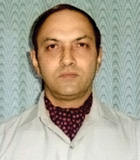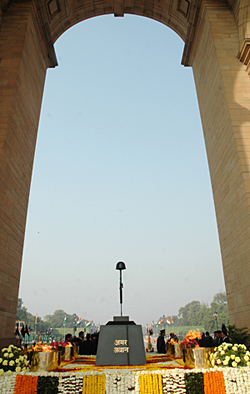INDIAN ARMED FORCES CHIEFS ON
OUR RELENTLESS AND FOCUSED PUBLISHING EFFORTS

SP Guide Publications puts forth a well compiled articulation of issues, pursuits and accomplishments of the Indian Army, over the years

I am confident that SP Guide Publications would continue to inform, inspire and influence.

My compliments to SP Guide Publications for informative and credible reportage on contemporary aerospace issues over the past six decades.
A National War Memorial in India
 |
By Lt General V.K. Kapoor (Retd) |
Backdrop

Photo Credit: PIB
The clamour for a national war memorial from the armed forces and even non government bodies has been fairly loud in the past decade or so. This is especially noteworthy because in the past 67 years since independence, the Indian Armed forces have been constantly involved in military operations either at the international border, or at the line of control (LoC) with Pakistan or at the line of actual control (LAC) with China or fighting insurgencies or militancy internally. The causalities suffered by the armed forces even if counted from independence onwards runs into thousands of jawans and officers.
It now seems that, after repeated requests by the military, the Government of India has decided to erect a National War Memorial in the vicinity of the India Gate, New Delhi, to honor its Armed Forces and memorialize armed forces members killed in war after Independence in 1947. It has also been decided that a War Museum will be constructed in the adjoining Princes Park area. The proposed National War Memorial and the War Museum will be connected by a subway. The War Memorial and Museum are expected to cost 400 crore ,(US$60 million).
The memorial is expected to be made around the existing chhatri (canopy) near India Gate. The memorial wall will be flushed with the ground and in harmony with existing aesthetics. Names of martyrs killed in wars in 194748, 1961 (Goa), 1962 (Chinese aggression), 1965, 1971, 1987 ( Saichen), 1987-88 (Sri Lanka), 1999 (Kargil), and other Operations will be inscribed on a memorial wall. Assistance of foreign architects is expected to taken. The Government is expected to issue a global tender for the construction of the War memorial.
The museum at the adjoining Princess Park will be largely underground, and connected to the Chhatri area via a subway. The Princess Park, is a 14-acres area north of India Gate, with barrack-type accommodation, built during World War II, which since 1947 has served as family accommodation for mid level armed forces officers posted in Service Headquarters in New Delhi.
Important Timelines connected to the National War Memorial
- In 2009 in the face of persistent demand from the armed forces and armed forces veterans for a national war memorial in the India Gate area, the United Progressive Alliance (UPA) government half heartedly constituted Group of Ministers' (GoM) headed by Pranab Mukherjee (before he became the President) to examine the demand for a National War Memorial.
- On 20 October 2012, after a lapse of 50 years, the government decided to mark the anniversary of the 1962 War launched by Chinese forces in Tibet against Indian border defenses, on 20 October 1962, by a solemn ceremony at the Amar Jawan jyoti, to honor Indian soldiers killed in the 1962 war. At the ceremony attended by chiefs of the armed forces, AK Antony, the Defenses Minister, announced that the Government has conceded the long-standing demand of the Indian Armed Forces for a National War Memorial, and that a national war memorial will be built at India Gate. He added that the group of ministers has cleared all outstanding issues on the matter and the armed forces will finally get their wish.
- In December 2012 Sheila Dikshit, Chief Minister of Delhi, in separate letters to Defence Minister A K Antony, Home Minister Sushil Kumar Shinde and Urban Development Minister Kamal Nath, opposed the recommendations of the GOM to build a national war memorial at the India Gate complex. The Urban Development Ministry and the Delhi Urban Art Commission were in agreement with the recommendations of Sheila Dikshit, Chief Minister of Delhi. The response of the Delhi Chief minister and the UPA government was a source of much discontentment amongst members of the armed forces.
- On 28 January 2014, Shri Narendra Modi, before he became Prime Minister of India, at a political rally two days after the national Republic Day, said "There is no country in the world where there is not a war memorial. India has fought several wars, thousands of our soldiers have been martyred. Should we not remember them? Should not there be a war memorial".
- On 10 July 2014 Arun Jaitley, Finance Minister and Defence Minister of India, while making the allocation for the War memorial in Budget said, "I am happy to announce the war memorial will be constructed in the Princess Park. It will be supplemented by a war museum. I am allocating a sum of 100 crore for this purpose".
- On 21 August 2014 the decision to build the national war memorial, and the War Museum, was approved at a meeting attended by Arun Jaitley, Indian Defense Minister at that time, and the Armed Forces chiefs, Air Chief Marshal Arup Raha, Admiral Robin Dhowan and General Dalbir Singh Suhag. The final decision is expected to approved by the cabinet.
Cabinet Clearance
On Wednesday, 07 Oct 2015, the Union Cabinet approved the construction of a National War Museum at Princess Park, near India Gate, New Delhi, in memory of all Indian soldiers who have made the supreme sacrifice for the country post-independence. The estimated cost of the project will be around 500 crore and the total time for completion of the entire project is estimated to be five years, Union Surface Transport Minister Nitin Gadkari said, briefing reporters about the Cabinet decisions.





